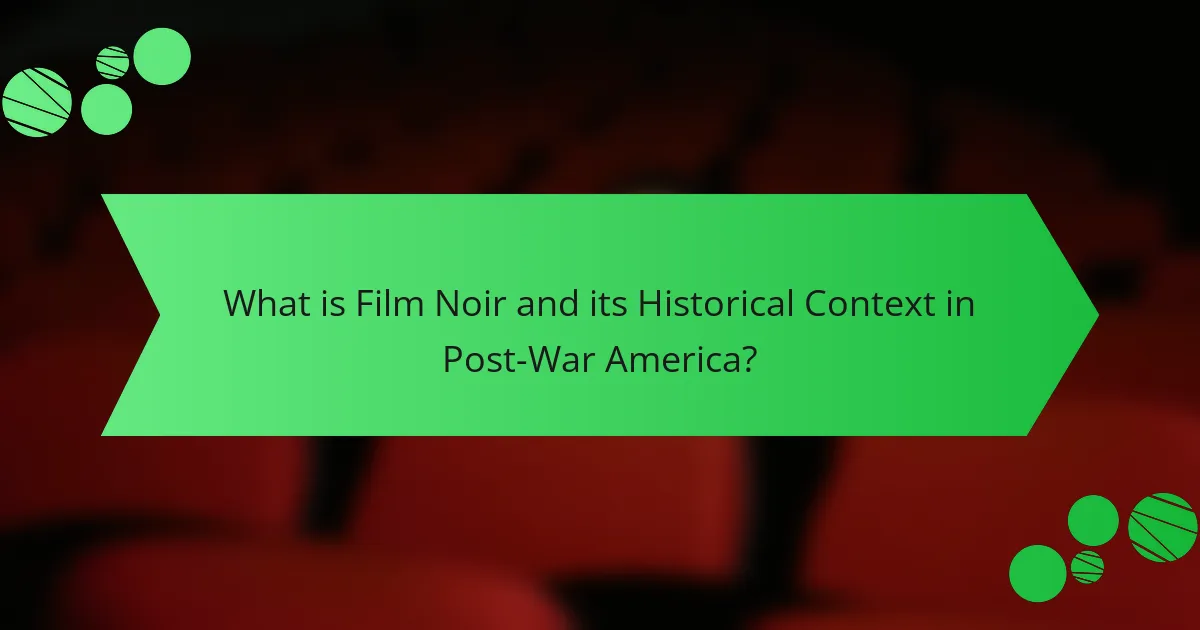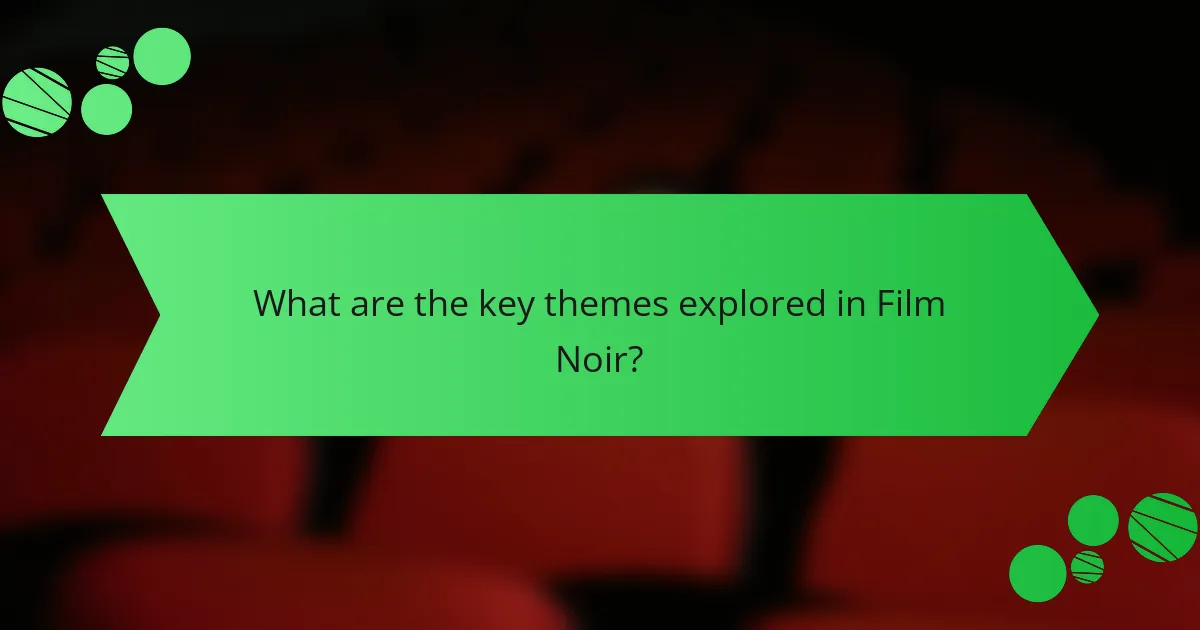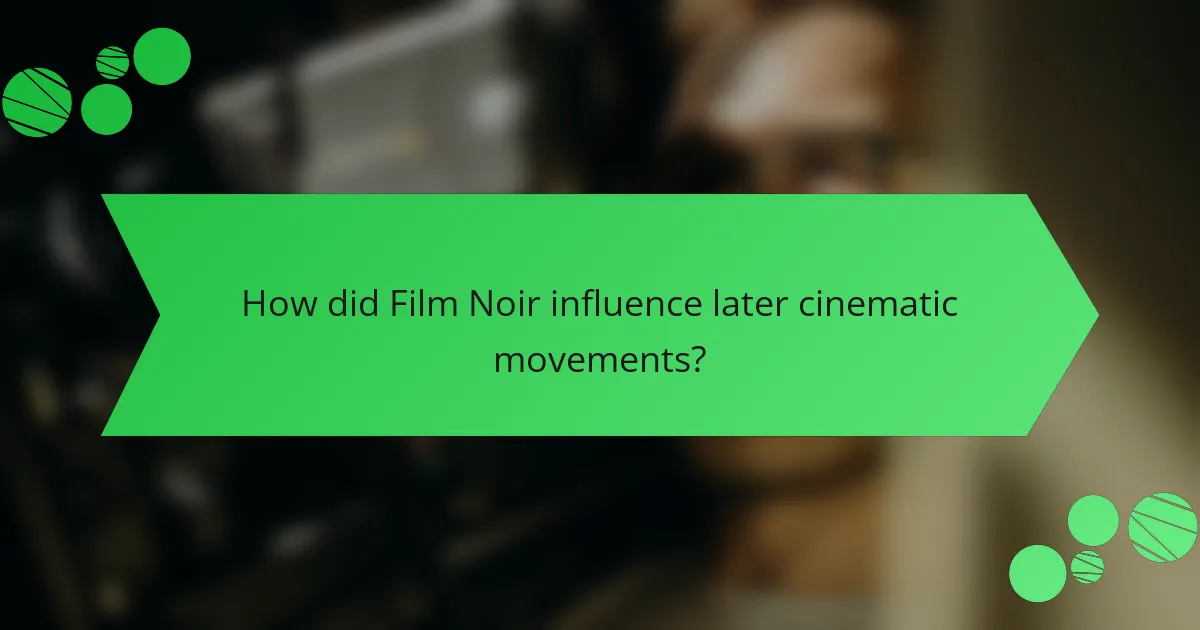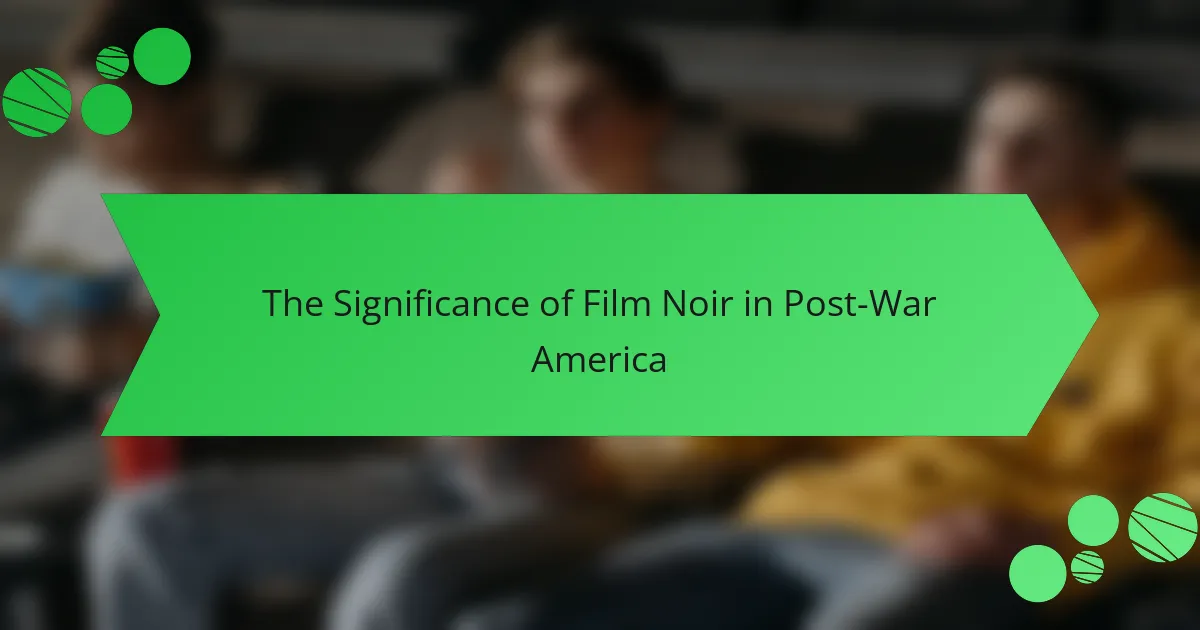
What is Film Noir and its Historical Context in Post-War America?
Film Noir is a cinematic style characterized by its dark themes, moral ambiguity, and visual elements such as low-key lighting. It emerged in the 1940s and became prominent in post-war America. This genre reflects the anxieties and disillusionment of the American public following World War II. The war had left many grappling with trauma and uncertainty about the future. Film Noir often features protagonists who are flawed and face existential dilemmas. The historical context includes a shift in societal values and an exploration of crime and corruption. Notable films include “Double Indemnity” and “The Maltese Falcon,” which exemplify these themes. The genre also influenced later filmmaking and continues to resonate in contemporary cinema.
How did Film Noir emerge as a genre in the post-war era?
Film Noir emerged as a genre in the post-war era due to societal changes and cinematic influences. The end of World War II brought about a shift in American culture. Disillusionment and a sense of moral ambiguity characterized the period. This environment influenced filmmakers to explore darker themes. The visual style of Film Noir was inspired by German Expressionism. Elements such as stark lighting and urban settings became prevalent. Additionally, the rise of hardboiled detective fiction shaped narrative structures. Iconic films like “The Maltese Falcon” and “Double Indemnity” exemplified these trends. Collectively, these factors solidified Film Noir’s place in post-war American cinema.
What cultural and societal influences shaped Film Noir’s development?
Film Noir’s development was shaped by cultural and societal influences such as World War II, the Great Depression, and urbanization. The aftermath of World War II introduced themes of disillusionment and moral ambiguity. Soldiers returning home faced a changed society, which influenced the darker narratives in Film Noir. The Great Depression created a sense of desperation and survival, reflected in the genre’s characters and storylines. Urbanization led to the portrayal of gritty city landscapes, emphasizing isolation and danger. Additionally, the rise of existential philosophy contributed to the themes of fate and free will present in Film Noir. These influences collectively shaped the genre’s aesthetic and thematic depth.
How did World War II impact the themes of Film Noir?
World War II significantly impacted the themes of Film Noir by introducing elements of disillusionment and moral ambiguity. The war’s aftermath left many individuals questioning traditional values and authority. This shift is reflected in Film Noir’s portrayal of flawed characters and complex narratives. The psychological trauma experienced by soldiers contributed to themes of paranoia and existential dread. Additionally, the socio-economic changes post-war led to a rise in crime and corruption, which are prevalent in Film Noir stories. The genre often depicted urban settings filled with shadows and danger, mirroring the uncertainty of the era. Overall, Film Noir became a lens through which post-war America processed its collective trauma and disillusionment.
Why is Film Noir significant in American cinema?
Film Noir is significant in American cinema for its unique style and thematic depth. It emerged in the 1940s and 1950s, reflecting post-war societal anxieties. The genre is characterized by its use of low-key lighting and urban settings. It often features morally ambiguous characters and complex narratives. Film Noir explores themes of existentialism and disillusionment. Classic examples include “Double Indemnity” and “The Maltese Falcon.” These films influenced later cinematic styles and genres. Film Noir has left a lasting impact on American storytelling and visual aesthetics.
What are the defining characteristics of Film Noir films?
Film Noir films are defined by their dark, cynical tone and moral ambiguity. They often feature a protagonist who is a flawed anti-hero. The visual style includes high-contrast lighting and shadowy compositions. Common themes include crime, betrayal, and existential despair. The narratives typically involve complex plots with twists and turns. Female characters are often portrayed as femme fatales, leading men to their downfall. The setting often reflects urban environments, enhancing a sense of isolation. Film Noir emerged in the 1940s and 1950s, influenced by wartime disillusionment and societal anxieties.
How does Film Noir reflect the anxieties of post-war America?
Film Noir reflects the anxieties of post-war America through its themes of moral ambiguity, existential dread, and societal disillusionment. These films often depict a world where traditional values are questioned. Characters frequently face betrayal, corruption, and a loss of identity. This mirrors the uncertainty experienced by Americans after World War II. The return of soldiers led to economic changes and social upheaval. Many films showcased the darker aspects of urban life, highlighting crime and paranoia. The visual style, characterized by shadows and stark contrasts, enhances the themes of isolation and despair. Overall, Film Noir serves as a cultural commentary on the fears and complexities of a rapidly changing society.

What are the key themes explored in Film Noir?
Key themes explored in Film Noir include moral ambiguity, existential despair, and the darker aspects of human nature. These themes reflect the disillusionment of post-war America. Characters often face ethical dilemmas, showcasing a blurred line between right and wrong. The use of femme fatales highlights themes of seduction and betrayal. Additionally, urban settings create a sense of isolation and entrapment. The narrative often involves crime and punishment, emphasizing the consequences of choices. Overall, Film Noir encapsulates a pessimistic view of society, mirroring the anxieties of the era.
How do themes of morality and existentialism manifest in Film Noir?
Themes of morality and existentialism manifest in Film Noir through complex characters and moral ambiguity. Protagonists often face ethical dilemmas that challenge their values. These characters typically operate in a morally gray world, where right and wrong are not clearly defined. Existentialist themes emerge as characters grapple with their purpose and the absurdity of their situations. The genre frequently depicts a sense of hopelessness and the struggle for meaning in a chaotic environment. Classic examples include films like “Double Indemnity” and “The Maltese Falcon,” where characters confront their choices and the consequences that follow. The visual style, with its use of shadows and stark contrasts, reinforces the themes of alienation and moral conflict. Overall, Film Noir serves as a reflection of post-war anxieties and the search for identity amid uncertainty.
What role does the anti-hero play in Film Noir narratives?
The anti-hero in Film Noir serves as a complex protagonist who embodies moral ambiguity. This character often operates outside societal norms and legal boundaries. Anti-heroes in Film Noir typically display traits such as cynicism, disillusionment, and a flawed sense of justice. Their motivations are often driven by personal gain or revenge rather than altruism.
The presence of the anti-hero reflects the post-war disillusionment prevalent in American society. Film Noir emerged after World War II, capturing the zeitgeist of uncertainty and moral complexity. Classic examples include characters like Sam Spade in “The Maltese Falcon” and Walter Neff in “Double Indemnity.” These characters challenge traditional heroism, presenting a darker view of human nature.
The anti-hero’s journey often leads to inevitable tragedy, reinforcing themes of fate and existential despair. Their struggles highlight the conflict between individual desires and societal expectations. In summary, the anti-hero is central to Film Noir, embodying the era’s complexities and moral dilemmas.
How does Film Noir portray gender roles and relationships?
Film Noir portrays gender roles and relationships through complex character dynamics and societal critiques. Women in Film Noir often embody the archetype of the femme fatale. This character type uses sexuality to manipulate men, reflecting a shift in traditional gender roles. Men, typically depicted as hard-boiled detectives or anti-heroes, navigate a world filled with moral ambiguity. Their relationships with women often reveal vulnerability and conflict.
Film Noir emphasizes themes of betrayal and power struggles. The interplay between male and female characters highlights issues of trust and deception. For instance, films like “Double Indemnity” showcase how women can exert power over men, challenging patriarchal norms. Moreover, the psychological tension in these relationships often leads to tragic outcomes, reinforcing the genre’s darker themes.
Overall, Film Noir serves as a lens to examine the evolving perceptions of gender roles in post-war America. It reflects anxieties about changing societal norms and the complexities of human relationships during that era.
What visual and stylistic elements define Film Noir?
Film Noir is defined by its distinctive visual and stylistic elements. Key visual elements include high-contrast lighting, often featuring deep shadows and stark highlights. This chiaroscuro effect creates a moody atmosphere. Additionally, the use of low-angle shots emphasizes the characters’ moral ambiguity. Stylistically, Film Noir often employs voice-over narration to provide insight into characters’ thoughts. The narrative structure frequently includes flashbacks and non-linear timelines. The themes of existential despair and moral complexity are prevalent throughout. Iconic visual motifs include urban settings, rain-soaked streets, and smoke-filled rooms. These elements collectively contribute to the genre’s unique aesthetic and thematic depth.
How does cinematography contribute to the mood of Film Noir films?
Cinematography significantly contributes to the mood of Film Noir films through its use of lighting, camera angles, and composition. Low-key lighting creates deep shadows, enhancing feelings of tension and mystery. This technique often highlights the moral ambiguity of characters. Unique camera angles, such as Dutch tilts, evoke unease and disorientation. Composition often features claustrophobic framing, reinforcing themes of entrapment. The interplay of light and shadow symbolizes the struggle between good and evil. Historical context shows that these techniques were prevalent in post-war cinema, reflecting societal anxieties. Overall, cinematography shapes the distinctive atmosphere that defines Film Noir.
What is the significance of lighting and shadow in Film Noir aesthetics?
Lighting and shadow are crucial in Film Noir aesthetics. They create a mood of tension and uncertainty. High contrast lighting emphasizes the moral ambiguity of characters. Shadows often symbolize danger or deception. This visual style reflects the psychological complexity of post-war America. The use of chiaroscuro enhances the dramatic effect of scenes. Historical context shows that these techniques were influenced by German Expressionism. Films like “Double Indemnity” exemplify this artistic approach.

How did Film Noir influence later cinematic movements?
Film Noir significantly influenced later cinematic movements by establishing stylistic and thematic conventions. Its use of low-key lighting and stark contrasts shaped the visual language of future genres. The emphasis on moral ambiguity and flawed characters became a staple in modern storytelling. Additionally, Film Noir’s narrative techniques, such as non-linear storytelling, inspired filmmakers in the 1960s and beyond. This influence is evident in the works of directors like Martin Scorsese and Quentin Tarantino. They adopted elements of Film Noir to explore complex themes and character arcs. The genre’s impact can also be seen in neo-noir films, which revisit and reinterpret classic noir tropes. Overall, Film Noir laid the groundwork for a more sophisticated approach to narrative and aesthetics in cinema.
What are the connections between Film Noir and neo-noir films?
Film Noir and neo-noir films share thematic and stylistic connections. Both genres explore crime, moral ambiguity, and complex characters. Film Noir originated in the 1940s and 1950s, characterized by its dark visual style and pessimistic tone. Neo-noir emerged in the late 20th century, updating these elements for contemporary audiences.
Neo-noir incorporates modern storytelling techniques and technology while retaining the essence of Film Noir. Common motifs include femme fatales, antiheroes, and urban settings. Both genres often reflect societal anxieties and moral dilemmas. Notably, neo-noir films like “Blade Runner” and “Chinatown” pay homage to classic Film Noir while introducing new narratives.
The connections between these two genres highlight their influence on each other across decades.
How have contemporary filmmakers drawn inspiration from Film Noir?
Contemporary filmmakers have drawn inspiration from Film Noir through stylistic choices and thematic elements. They often utilize low-key lighting and high-contrast visuals reminiscent of classic Noir. This visual style enhances mood and tension in their narratives. Additionally, themes of moral ambiguity and existential dread are prevalent in modern storytelling. Filmmakers like Christopher Nolan and David Fincher incorporate these elements into their works. For example, Nolan’s “Memento” reflects the fragmented narratives typical of Noir. Fincher’s “Se7en” showcases the bleak outlook on humanity found in classic Noir films. These influences demonstrate the enduring legacy of Film Noir in shaping contemporary cinema.
What legacy does Film Noir leave in modern storytelling?
Film Noir leaves a lasting legacy in modern storytelling through its themes and stylistic elements. It introduces complex characters, often morally ambiguous, which influence contemporary narratives. The use of voice-over narration and non-linear storytelling can be traced back to Film Noir. Its visual style, characterized by high contrast lighting and urban settings, continues to inform cinematography today. Additionally, the exploration of existential themes and psychological depth has shaped modern character development. Many modern films and series draw inspiration from the tension and suspense inherent in Film Noir plots. The genre’s impact is evident in works like “Blade Runner” and “Sin City,” which pay homage to its conventions. Overall, Film Noir’s influence is pervasive in the way stories are told in cinema and television.
How have the themes of Film Noir evolved in today’s cinema?
The themes of Film Noir have evolved significantly in today’s cinema. Modern films incorporate psychological complexity and moral ambiguity. They often reflect contemporary societal issues such as corruption and existential dread. Female characters have gained more agency compared to the classic damsels in distress. Visual styles have also adapted, using advanced cinematography techniques. Streaming platforms have allowed for broader narrative experimentation. For example, films like “Gone Girl” and “Nightcrawler” embody these evolved themes. They showcase intricate plots and flawed protagonists. This evolution demonstrates Film Noir’s lasting influence on storytelling in modern cinema.
What can viewers learn from studying Film Noir?
Viewers can learn about the complexities of human nature through studying Film Noir. This genre often explores themes of moral ambiguity and existential despair. Characters in Film Noir frequently face ethical dilemmas that reveal their true selves. The visual style of Film Noir, characterized by stark lighting and shadows, enhances these themes. Historical context shows that Film Noir emerged after World War II, reflecting societal anxieties. The narratives often depict a world filled with deception and betrayal. By analyzing character motivations, viewers gain insight into psychological struggles. Ultimately, Film Noir serves as a lens to examine post-war American culture and its disillusionment.
How can understanding Film Noir enhance the appreciation of film as an art form?
Understanding Film Noir enhances appreciation of film as an art form by revealing its thematic depth and stylistic innovation. Film Noir explores complex moral ambiguities and human psychology. It often features anti-heroes and bleak narratives, reflecting societal anxieties of post-war America. The visual style incorporates high-contrast lighting and unconventional camera angles. This distinct aesthetic creates a mood that engages viewers on multiple levels. Historical context shows that Film Noir emerged in the 1940s and 1950s, influenced by the trauma of World War II. The genre’s unique storytelling techniques challenge traditional narrative forms, promoting critical analysis. By studying Film Noir, audiences gain insight into cultural values and artistic expression during a pivotal era.
Film Noir is a cinematic genre that emerged in post-war America, characterized by dark themes, moral ambiguity, and distinctive visual elements such as low-key lighting. This article explores the historical context of Film Noir, highlighting its reflection of societal anxieties following World War II, as well as its defining characteristics, key themes, and the role of the anti-hero. Additionally, it examines how Film Noir has influenced later cinematic movements and contemporary storytelling, including its legacy and evolution in modern cinema. The article underscores the significance of Film Noir in shaping American film aesthetics and narrative complexity.
